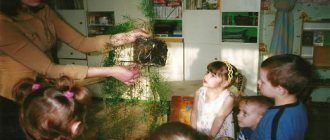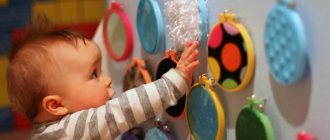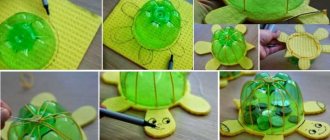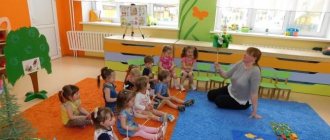Legal education of preschool children - concept and definition
Everyone wants to live in a fair, legal state. To do this, everyone should exercise their rights and freedoms.
It is required to raise a right-educated person from childhood.
Usually, legal education means the formation of social activity in an individual, the formation of mental abilities and a value-based attitude to personal rights, and the ability to act in accordance with one’s rights prescribed in the law of the country.
Legal education is most often considered in terms of moral education. If a child does not know moral standards, then he will not respect the rights of others. And knowledge of rights will only be of a memorized, formal nature.
Children 6-7 years old understand very well when they are treated unfairly in the family or when their favorite cartoon character is offended. It is precisely such manifestations of the child’s feelings that can, and even should, be relied upon during legal training.
As for the legal education of preschool children, this is a very important stage of personal formation. At this age, both the bad and good sides of the child’s personality develop.
If during this period you pay close attention to the development of the child’s legal thinking, then you don’t have to worry about his future. The child will not allow himself to be offended, and will not infringe on the rights of others.
The main legal aspects at this age include the rights to play, love and attention from the adults around him. A child in a family must be protected from humiliation and violence.
Legal education helps to form a legal basis for a preschooler, which includes three interconnected components.
- moral and legal ideas are the first component;
- moral and legal judgments are the second component;
- the child’s value orientations, adequate ideas and judgments of behavior in a group of children and adults.
Young lawyer
Educational game on legal education for children of senior preschool age.
The proposed game helps preschoolers study and consolidate the legal foundations, fosters a respectful attitude towards human rights, develops a child’s sense of self-esteem, as well as a correct and fair view of life situations, and develops his emotional and personal qualities.
In modern society, legal education of citizens plays a huge role. Legal norms make it possible to streamline social relations and people's behavior. From the very first steps that a child takes independently, choosing methods of behavior, knowledge of the rules of law should help him. Our task is to give children this knowledge in a very correct, exciting, age-appropriate form.
The game “Young Lawyer” is educational and designed to help preschool teachers and parents organize joint activities for children to study legal principles. Has great pedagogical potential. The variability of the game helps to reach children of different ages and with different levels of knowledge.
Purpose of the game
- Create conditions for the development of children's positive sense of self, social skills and communicative behavior. Learn to distinguish between the concepts of “should”, “can”, “want”, and improve knowledge about social norms.
- To provide legal knowledge that helps broaden one’s horizons, develop self-esteem, awareness of one’s rights and freedoms, and a sense of responsibility.
- Foster a respectful attitude towards human rights and a desire to fulfill them.
- Develop the ability to perceive a schematic image and relate it to the real situation.
The game consists of three sets of cards that carry the same information, but are presented in different ways:
- Five cards with text information (text cards).
- Five cards with a schematic image (cardschemes).
- Twenty cards with colorful illustrative images of situations (situational cards).
Cards-schemes and text cards are divided into four sectors, each of which carries information about a specific right or obligation.
In the central part of these cards, a square is attached in such a way that it forms pocket corners into which you can insert corresponding situational pictures. All cards are in a box, colorfully decorated in accordance with the theme of the game. Number of participants: from 1 to 5 people (adult participation required).
Pedagogical possibilities of the game:
- Children learn to interact in a team.
- They receive information about rights and responsibilities and learn to distinguish between them.
- Have the opportunity to demonstrate their competence.
- Learn to set goals and achieve results.
- Bright colorful cards, clear, graphic and understandable schematic compositions, the correct font without unnecessary elements - all this allows children to easily navigate the course of the game, remember and compare different forms of presenting information.
Progress of the game
The leader is an adult, the participants are children.
Each participant in the game is given diagram cards or text cards (a guide to the child’s knowledge, skills and abilities). The adult offers the children story cards one by one. The child must correlate the plot of the card with the information located in the sectors of diagram cards or text cards. The child takes a card and inserts it into his pocket if the plot matches the information in one of the sectors. (In the process of recognizing the plot, the presenter can include various methodological techniques: role-playing dramatizations, exercises for the development of the emotional sphere, composing plot mini-stories and dialogues, logorhythmic and gaming exercises.) The game is considered complete if all the corner pockets are occupied by cards. At the end of the game, it is recommended to hold a “Feast of Law” in order to consolidate the knowledge acquired during the game.
Methodological recommendations for successful execution of the game
If your child has not yet learned to read, the game task is based on cards-schemes. The educational value of this version of the game is that children, by looking at a schematic image, learn to perceive the diagram and transfer it to a real image or situation.
In our complex world there are a huge variety of signs, patterns and symbols. They are everywhere - in the clinic, school, on the road, in the subway. They need to be understood when working with a computer and educational literature. Also, during the game, the main game task is realized - the legal education of the child.
Tip: Don't make your children sit at the table for a long time, sorting through game cards. Keep them active. Include physical exercises and logorhythmic exercises that correspond to the topic into the gameplay.
As for text cards, you can include them in the game if the child is already able to read and comprehend text information. I think that many adults will agree with me: the topic of law in itself does not have much appeal for children, so our task is to use such techniques, methods and methods of presentation so that it shines with new, bright and exciting facets.
While working with cards, integrate various educational areas: read fiction, listen to music recordings, compose short situational stories and dialogues based on the chosen plot. The topic of law can be presented in a very interesting and accessible way using the example of fairy tales:
- The right to housing can be traced in fairy tales: “Zayushkina’s hut”, “Rukavichka”, “Teremok”.
- The right to life is in fairy tales: “Geese-Swans”, “Sister Alyonushka and Brother Ivanushka”.
- Humane treatment of animals is in the fairy tale: “Grandfather Mazai and the Hares.”
And there are a lot of such examples, you just have to use your imagination.
Elena Gimadeeva, teacher at MADOU “Kindergarten No. 141”,
Kazan, Republic of Tatarstan
Documents protecting children's rights
Children's rights are protected by both international and Russian legislation.
The Universal Declaration of Human Rights has a separate section on children's rights, which recognizes the equal rights of children to all the freedoms that the Declaration and the international community proclaim.
Such legal protection requires additional support and assistance for children. The atmosphere in which a little person is raised should be filled with kindness and love. Every child has the right to grow up in a loving family, surrounded by attention and care. In the future, the child must become a full citizen of his country. And parents and teachers will help with this.
The next document on legal education is the Geneva Declaration of the Rights of the Child. It was adopted in 1924 and remains relevant to this day.
In 1959, the UN adopted another document reflecting and proclaiming legal principles regarding the protection and prosperous life of children. This document clearly articulates the need for special protection and care, and legal protection of the child, starting from his prenatal existence. This document contains 10 principles aimed at creating a happy childhood for our kids.
Another document of children's rights is the Convention, drawn up out of necessity. A declaration alone is no longer enough. By 1970, cases of child abuse in the family had become more frequent, and the need arose to create a new document on the rights of the child.
To this end, a new Declaration on the Protection of Women and Young Children in Difficult Circumstances was drawn up in 1974. Military conflicts and armed clashes became such emergency situations.
Over the years, society has been creating more and more new documents and passing laws so that our children can live a peaceful life.
The child must grow up in conditions favorable to him and must know what he has the right to.
Methods of legal education of preschool children in preschool educational institutions
In kindergarten, it is advisable to first diagnose children’s legal knowledge, legal awareness, and needs for moral and legal behavior.
The level of legal education of preschool children will depend on how clearly the work of the institution’s teachers is in solving the problem under consideration.
Diagnosis should be carried out according to the following criteria of legal education in children:
- the volume and content of the child’s ideas about the rights and freedoms of citizens;
- the nature of legal judgments, how the child expresses his attitude to certain norms;
- the child’s ability to obey moral requirements, to act according to the situation, respecting his own and others’ rights.
The first criterion is classified as cognitive, since it carries a cognitive function.
The second criterion is characterized by the expression of assessment and personal attitude, therefore it is emotional and evaluative.
The third criterion, behavioral, plays one of the important roles, because the child shows his upbringing to others.
Rude shouting at children and cruel punishment for any disobedience are unacceptable within the walls of a kindergarten. This insults the dignity of the little person.
Children learn to act according to what they see and follow the example of their teachers. The personality of the teacher is an example to follow.
If an adult is respectful of others and values the rights of children and the adults around them, then the students will act accordingly.
Friendly mutual communication during games, experiments, practical and project activities will have a positive effect on the behavior of preschool children.
Means of legal education are selected taking into account the age characteristics of children.
In preschool educational institutions, when implementing legal education, special classes are organized in which various methods are used to familiarize children with their rights.
These may be activities with a moral orientation. Moral and legal education of a preschooler in classes and through play is carried out at least once a month. The material for the lesson is prepared in advance and carefully.
Games are suitable for children, both theatrical and role-playing and didactically. But they must have a special moral and legal basis.
The use of special games and exercises is encouraged, including tasks for the development of various skills in the field of legal morality.
In theatrical activities for the moral and legal education of preschoolers, it is good to use fairy tales familiar to children. Kids willingly imitate heroes and fairy-tale characters. They adopt from them, among other things, moral standards.
Didactic games can be called “I have rights”, “Whose rights am I violating”, “Rights of a fairy-tale hero”. Here we also use materials from fairy tales, since fairy tales are especially close to preschool children.
There is also a method for effective legal development of preschool children. This method is called dramatization. Exercises with this method lead to getting used to the image of the hero.
For moral and legal education, it is important to form basic elementary ideas about one’s rights and freedoms. Children must respect the rights of other people.
In any process, it is important to consolidate knowledge and acquired skills. Knowledge acquisition is achieved through children’s reproduction of learned actions. Children illustrate rights through visual activities, dramatize the correct and incorrect behavior and actions of literary characters.
Literary works of different types are used for moral and legal education. There are fairy tales, poems, and sayings. Stories and booklets depicting the rights and freedoms of children are very effective in this regard.
It is known that visibility is effective in shaping a child’s personality. If you do not use illustrations in the moral and patriotic education of your child, then many aspects will remain unlearned.
Such methods will encourage preschoolers to do the right thing in all situations.
MAGAZINE Preschooler.RF
EDUCATION OF LEGAL CULTURE OF SENIOR PRESCHOOL CHILDRENV.S. Dracheva, teacher at MBDOU "Kindergarten in the village of Grafovka, Shebekinsky district, Belgorod region"
The most important achievement of the Russian public education system is its reorientation towards the principles of humanization, towards educating the younger generation in the spirit of universal human values and ideals of peace. In light of this, two most important tasks are defined: social - a significant change in the situation of the child in Russia and pedagogical - the formation of an elementary legal culture of members of society.
Analyzing the current state of the problem of legal education, it should be noted that in the conditions of humanization, the main reason for its relevance is the increased interest in the individuality of the individual. Today it has become obvious that society needs a socially mature, free person with legal knowledge.
The deterioration of the situation of children, the decline in indicators of health and well-being, the increase in social maladjustment of children, manifested in violation of moral norms and illegal actions, require the intensification of state policy in the interests of children. The new ethics lies in the recognition of childhood as a full-fledged stage, a natural period of life for every child.
The task can be solved by constructing the entire process through multilateral activities based on cooperation, respect, trust in the child, through awareness in this process of the conditions for his self-realization as a social subject. Such changes are directly related to increased attention to the implementation of children's rights.
Among the most pressing is the problem of forming the legal consciousness of preschool children.
The formation of the foundations of the legal consciousness of preschool children is possible through the formation of its three components.
- Informational and cognitive - children’s knowledge of rights, knowledge of responsibilities.
- Emotional-evaluative - assessment of one’s own activities, the ability to evaluate the actions of other people from the point of view of legal norms.
- Behavioral-activity - skills and abilities to implement legal behavior, the ability to exercise one’s rights in activities, observe prohibitions and fulfill duties.
To correct the level of development of the information and cognitive component, we widely used conversations with children about rights and responsibilities, and familiarization with legal documents. Other activities - looking at illustrations, conversations based on pictures, observation, solving pedagogical situations, composing stories - were aimed at correcting the level of formation of the emotional and evaluative component of legal consciousness. Their goal is to expand children’s knowledge about moral and legal norms, the need to worry, show care and attention to each other, develop skills in joint activities, and cultivate mutual assistance and cooperation.
To correct the level of development of the behavioral and activity component, such work methods as organizing moral, legal, pedagogical and gaming situations, exercises, and explanation of negative actions were used.
To enrich children's knowledge about rights, during the first conversations we introduced older preschoolers to an important international document - the Convention on the Rights of the Child .
This was followed by conversations on the topic “What is law” , designed to expand children’s knowledge of such concepts as “right” and “desire” . Then conversations were held on the topic: “Right to life” , “Right to family” , “Right to development” , “Right to education” , “Right to protection” , “Right to medical care” , “Rights and responsibilities of children” .
Pedagogical situations and games aimed at developing one of the components of legal consciousness were selected.
The next area of work was the organization of a subject-spatial environment that would contribute to the accumulation of legal knowledge by children and an increase in the level of legal consciousness. The play corners were replenished with attributes for role-playing games and dramatization games.
We have developed educational games for Russian folk tales. For parents, stands were created with information about the rights and responsibilities of children, an exhibition of works of fiction, albums about the rights and responsibilities of children, corners for parents on the topic “Legal culture of the child .
The effectiveness of the process of forming the legal culture of children of senior preschool age largely depends on the targeted and systematic work of teachers and parents to improve their own legal culture. All activities of preschool educational institutions and families must be built on a solid legal basis. Here is a fragment of the lesson “Our rights” :
There are many genres in the world - fable, story and story, But from birth, children love magic and the world of embellishment.
What will our little people take to a magical world, Full of laughter, light, color? And they are called miracle fairy tales!
Children of all countries love fairy tales. Let's remember fairy tales in which the rights of fairy-tale heroes were violated.
Teacher. In which fairy tales are the rights to personal integrity, life and freedom violated?
Children. In the fairy tales “Little Red Riding Hood” , “Thumbelina” , “Sister Alyonushka and Brother Ivanushka” , in “The Tale of the Dead Princess and the Seven Knights” .
Teacher. In which fairy tales is the right to privacy of the home violated?
Children. In the fairy tales “The Three Little Pigs” , “Teremok” , “The Adventure of Cipollino” , “Zayushkina’s Hut” .
Teacher. Guys, today we talked to you about the rights of the child.
| Next > |
The effectiveness of legal education of preschool children in the family
The family is the first social institution into which a child enters from the moment of his birth.
The family has the main educational function in the moral and legal development of a preschooler. Often it is in the family that we encounter offenses between parents among themselves and towards their own children.
Such violations in the family affect the negative development of the child’s personality. A normally functioning family will give the child all the basic moral and legal knowledge. And, conversely, dysfunctions in family relationships lead to deviations of the preschool child from the norms of behavior in society, to deviations in the child’s legal consciousness.
First of all, the child needs to be introduced to the basic legal documents that list the rights of the individual. An older preschooler can already understand and remember some of the names of documents such as the Convention of Rights.
Next, you should develop respect and tolerance towards different people, regardless of nationality, skin color, gender and age. All people are equal.
Self-esteem will be effectively formed through the acceptance of one’s own rights, and respect for others through familiarizing children with the norms and rights of another person.
In the family, one should always emphasize and draw children's attention to the norms of behavior among people.
Features of legal education of preschool children through play
The game contributes to the development of moral and legal principles in children. Story-based role-playing games especially contribute to this. In such games it is easy to imagine various situations encountered in real life. You can create problematic situations and then play them out. Gradually they bring the child to understand the correct norms of behavior in society.
Game plots can be different. Playing with the rights to personal belongings, housing, family, parental love and attention to the child in the family and similar situations.
You can consider several games that contribute to the development of legal consciousness in children of senior preschool age.
Thematic control “Organization of work on the legal education of children”
Thematic control plan
“Organization of work on the legal education of children”
Target:
determine the level of organization of educational work in preschool educational institutions on the issues of legal education of preschool children.
| № n\n | Control issues | Suggested working materials | Deadlines | Responsible |
| 1 | Studying the level of knowledge development among preschool children about rights based on the creative and play week “Great rights of young children” |
| ||
| 2 | Assessment of professional skills of teachers. Methods, techniques, forms of work used by teachers |
| ||
| 3 | Assessment of long-term scheduling |
| ||
| 4 | Creating conditions for the formation of the legal culture of preschool children:
|
| ||
| 5 | Assessing forms of interaction with parents on this issue |
|
Map of self-analysis of the subject-developmental environment of the group
on the formation of legal culture among preschool children
| No. | Criteria | Points from 1 to 5 |
| 1. 1.1 | Richness of the subject-development environment Items that stimulate the development of universal human values (flag, coat of arms, works of art, etc.) | |
| 1.2 | Availability of didactic games and attributes for role-playing and theatrical games that implement the legal component | |
| 1.3 | Creation of a mini-library in a group (fiction, textbooks, audio, video materials) | |
| 1.4 | Creation of a card index of games for the formation of the legal culture of preschool children | |
| 1.5 | Availability of visual material on the formation of the legal culture of preschool children | |
| 2. 2.1 | Environment functionality Comprehensive ability to use objects, attributes (in all types of activities) | |
| 2.2 | Dynamic environment | |
| 2.3 | Accessibility of all items to the child | |
| 3. | Pedagogical feasibility | |
| 3.1 | Age targeting | |
| 3.2 | Individual targeting | |
| 3.3 | Pedagogical orientation of the environment | |
| 3.4 | Ensuring the comprehensive development of the child |
Visual information analysis map
for parents on issues of legal education of children
Period of execution: __________
| Age group (educators) | Visual information | Folders - moving | Help the group | Joint events | Photo exhibitions |
| I junior group “Droplet” | |||||
| First II junior group "Chamomile" | |||||
| Second II junior group "Bullseye" | |||||
| I middle group “Berry” | |||||
| II middle group "Smeshariki" | |||||
| I senior group “Zvezdochka” | |||||
| II senior group “Sweetie” | |||||
| Preparatory group "Sun" |
Conclusion:
Recommendations:
Questionnaire on legal education
Dear ____________________!
To improve the work of our preschool educational institution to protect the rights and dignity of the child, it is necessary to rely on your life and professional experience.
You can express your opinion on a number of issues in the questionnaire. Please fill it out. 1.
What international documents on the rights of the child do you know?
_______________________________________________________________________________________________________ 2.
Do you consider it necessary to protect the rights and dignity of the child in our country?
Yes, no
(underline as appropriate)
3.
If “Yes,” then what rights of the child are violated?
_______________________________________________________________________________________________________ 4.
What rights of the child must a preschool educational institution undertake to respect? _______________________________________________________________________________________________________
5.
What child rights are most often violated in the families of children in your group? _______________________________________________________________________________________________________
6.
What do you understand by legal education of children? _______________________________________________________________________________________________________
7.
Should parents be involved in the legal education of their children?
Yes, no
(underline as appropriate)
8.
At what age is it advisable to introduce a child to the legal culture of society, in particular to an awareness of human rights, including their own (underline as appropriate)
- from an early age
- from junior preschool
- from secondary preschool
- from senior preschool
- from primary school
9.
Is it possible to lead children of senior preschool age to understand such words as “right”, “freedom”, “law”, “equality”, “duty”, “international document”?
__________________________________________________________________________________________________ 10.
What means and methods should be used to form children’s ideas about human rights?
__________________________________________________________________________________________________ 11.
Do you have experience in raising children taking into account human rights?
Yes, no
(underline as appropriate)
12.
Would you like to increase the level of your knowledge about children’s rights and the legal education of preschool children?
Yes, no
(underline as appropriate)
Thanks for the help.
QUESTIONNAIRE FOR PARENTS
"Kindergarten and children's rights"
Dear moms and dads! Please answer the survey questions.
1. Are you familiar with the Convention on the Rights of the Child?_________________________________
2. How did you meet her ( underline as necessary
):
- at home, from the media;
- in kindergarten;
- from pedagogical literature;
- from other sources______________________________________________________________
3. What rights do you think a child has in kindergarten?____________________
___________________________________________________________________________
___________________________________________________________________________
4. What rights does a child have in the family?_____________________________________________
___________________________________________________________________________
5. What can you offer to monitor compliance with the rights of your children in kindergarten?_______________________________________________________________________
___________________________________________________________________________
___________________________________________________________________________
6. Is a permanent representative for children’s rights needed in a preschool institution?
____________________________________________________________________________
7. Do you know addresses, telephone numbers of organizations ( if possible, please indicate
), where can I turn to regarding the protection of the rights of a child in a difficult situation?_________________________________________________________________
Thank you very much!
Sincerely, the administration of MBDOU "Kindergarten No. 9"
List of sources used:
1. https://www.ds27.edusite.ru/p47aa1.html
2. https://rudocs.exdat.com/docs/index-391236.html?page=6
The full version of working with applications is available.








